Lacks Tracks Cycle: Evaluating Production Control and Performance
VerifiedAdded on 2021/11/16
|8
|1844
|25
Report
AI Summary
This report provides a comprehensive analysis of the production control functions at Lacks Tracks Cycle, a motorcycle manufacturer. It examines the company's manufacturing processes, comparing actual performance metrics against established standards across multiple plants. The analysis identifies significant deviations in areas such as utilization rate, production downtime, defective rates, and shipping damages. The report highlights the importance of implementing financial and quality control measures, including Total Quality Management (TQM) and quality assurance, to improve efficiency, reduce costs, and ensure the production of high-quality products. The study recommends specific corrective actions for individual plants, emphasizing the need for strategic modifications to address underperformance and align production metrics with company standards, ultimately aiming to enhance the company's competitiveness in the market. The report also discusses the importance of supervisory control for employee monitoring.
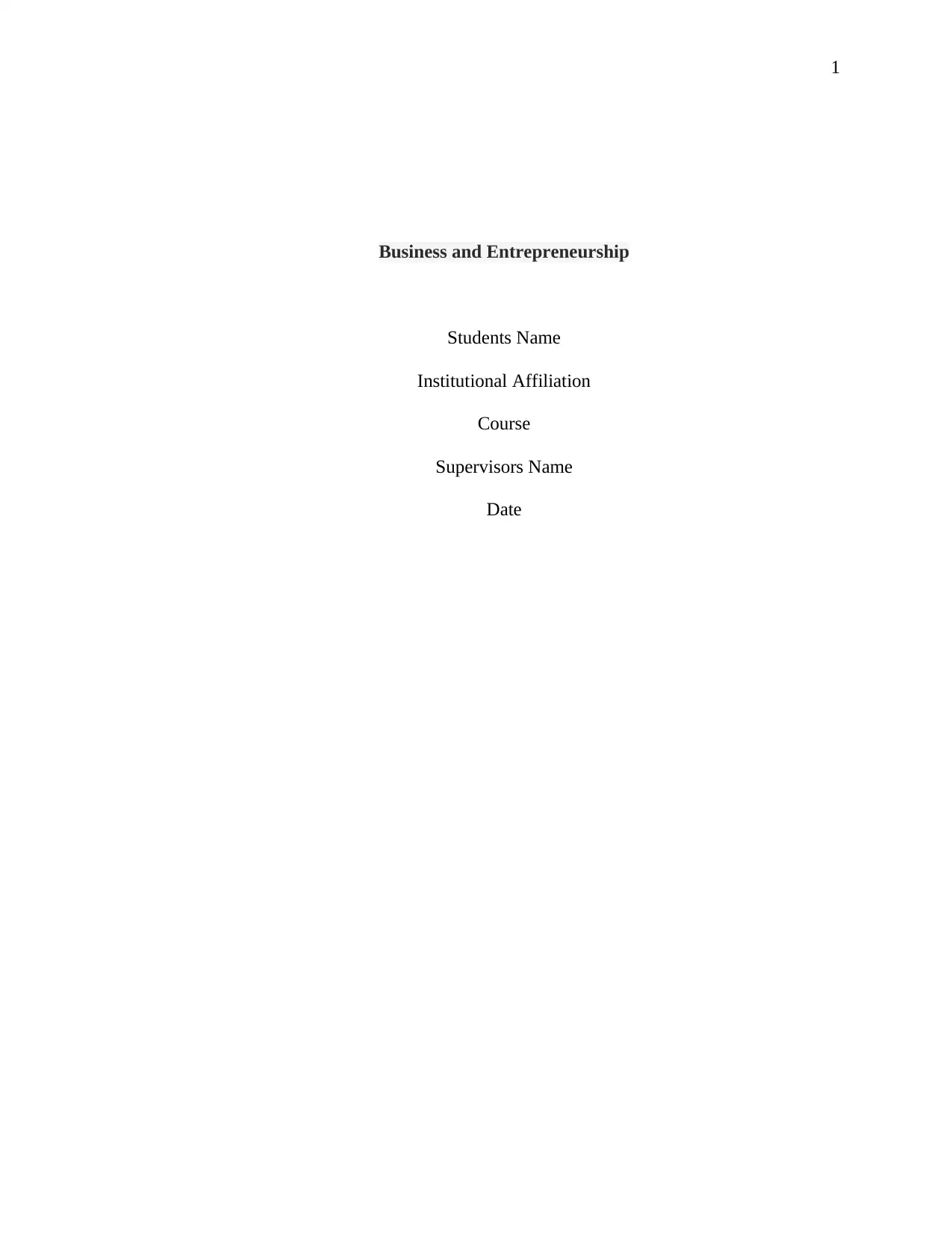
1
Business and Entrepreneurship
Students Name
Institutional Affiliation
Course
Supervisors Name
Date
Business and Entrepreneurship
Students Name
Institutional Affiliation
Course
Supervisors Name
Date
Paraphrase This Document
Need a fresh take? Get an instant paraphrase of this document with our AI Paraphraser
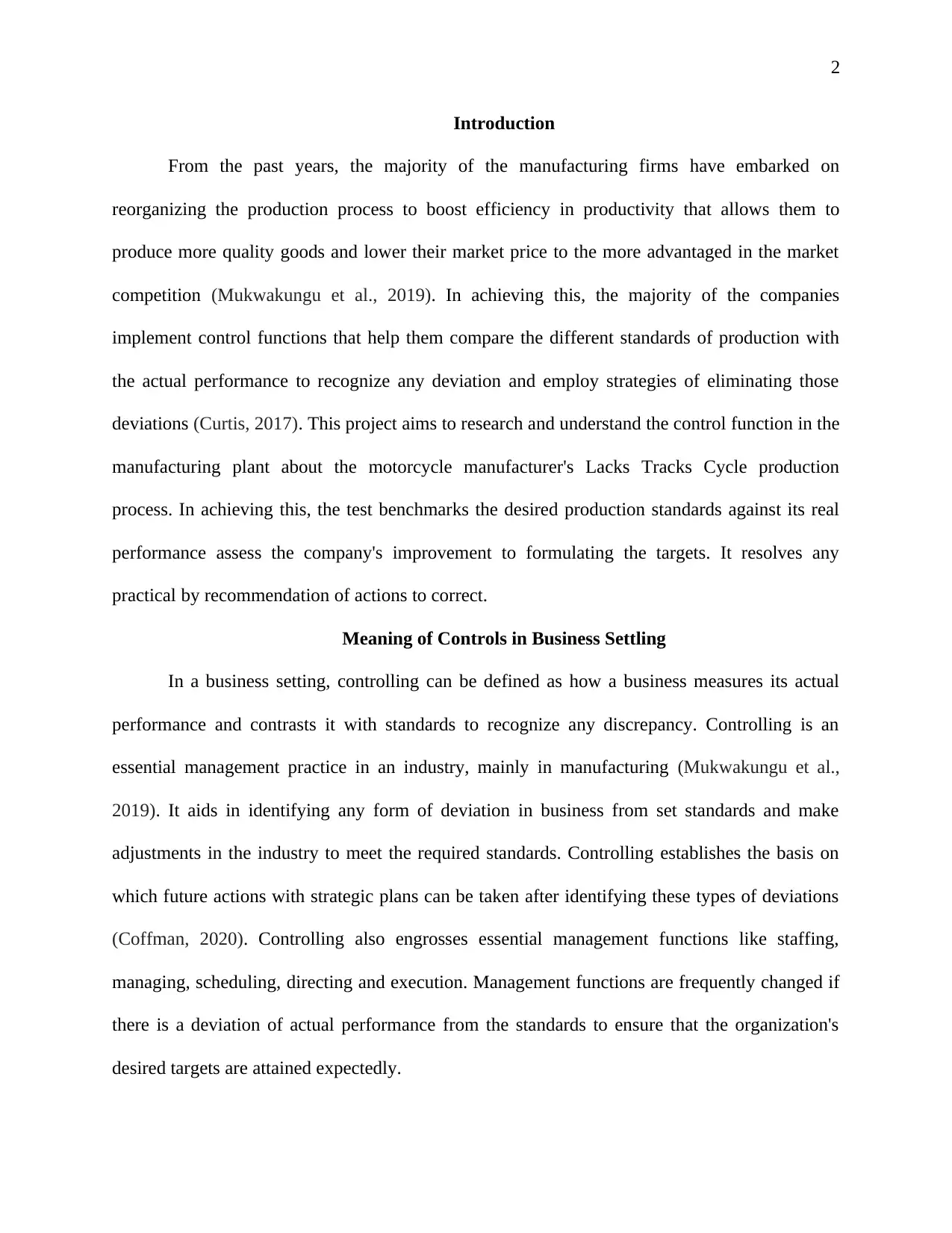
2
Introduction
From the past years, the majority of the manufacturing firms have embarked on
reorganizing the production process to boost efficiency in productivity that allows them to
produce more quality goods and lower their market price to the more advantaged in the market
competition (Mukwakungu et al., 2019). In achieving this, the majority of the companies
implement control functions that help them compare the different standards of production with
the actual performance to recognize any deviation and employ strategies of eliminating those
deviations (Curtis, 2017). This project aims to research and understand the control function in the
manufacturing plant about the motorcycle manufacturer's Lacks Tracks Cycle production
process. In achieving this, the test benchmarks the desired production standards against its real
performance assess the company's improvement to formulating the targets. It resolves any
practical by recommendation of actions to correct.
Meaning of Controls in Business Settling
In a business setting, controlling can be defined as how a business measures its actual
performance and contrasts it with standards to recognize any discrepancy. Controlling is an
essential management practice in an industry, mainly in manufacturing (Mukwakungu et al.,
2019). It aids in identifying any form of deviation in business from set standards and make
adjustments in the industry to meet the required standards. Controlling establishes the basis on
which future actions with strategic plans can be taken after identifying these types of deviations
(Coffman, 2020). Controlling also engrosses essential management functions like staffing,
managing, scheduling, directing and execution. Management functions are frequently changed if
there is a deviation of actual performance from the standards to ensure that the organization's
desired targets are attained expectedly.
Introduction
From the past years, the majority of the manufacturing firms have embarked on
reorganizing the production process to boost efficiency in productivity that allows them to
produce more quality goods and lower their market price to the more advantaged in the market
competition (Mukwakungu et al., 2019). In achieving this, the majority of the companies
implement control functions that help them compare the different standards of production with
the actual performance to recognize any deviation and employ strategies of eliminating those
deviations (Curtis, 2017). This project aims to research and understand the control function in the
manufacturing plant about the motorcycle manufacturer's Lacks Tracks Cycle production
process. In achieving this, the test benchmarks the desired production standards against its real
performance assess the company's improvement to formulating the targets. It resolves any
practical by recommendation of actions to correct.
Meaning of Controls in Business Settling
In a business setting, controlling can be defined as how a business measures its actual
performance and contrasts it with standards to recognize any discrepancy. Controlling is an
essential management practice in an industry, mainly in manufacturing (Mukwakungu et al.,
2019). It aids in identifying any form of deviation in business from set standards and make
adjustments in the industry to meet the required standards. Controlling establishes the basis on
which future actions with strategic plans can be taken after identifying these types of deviations
(Coffman, 2020). Controlling also engrosses essential management functions like staffing,
managing, scheduling, directing and execution. Management functions are frequently changed if
there is a deviation of actual performance from the standards to ensure that the organization's
desired targets are attained expectedly.
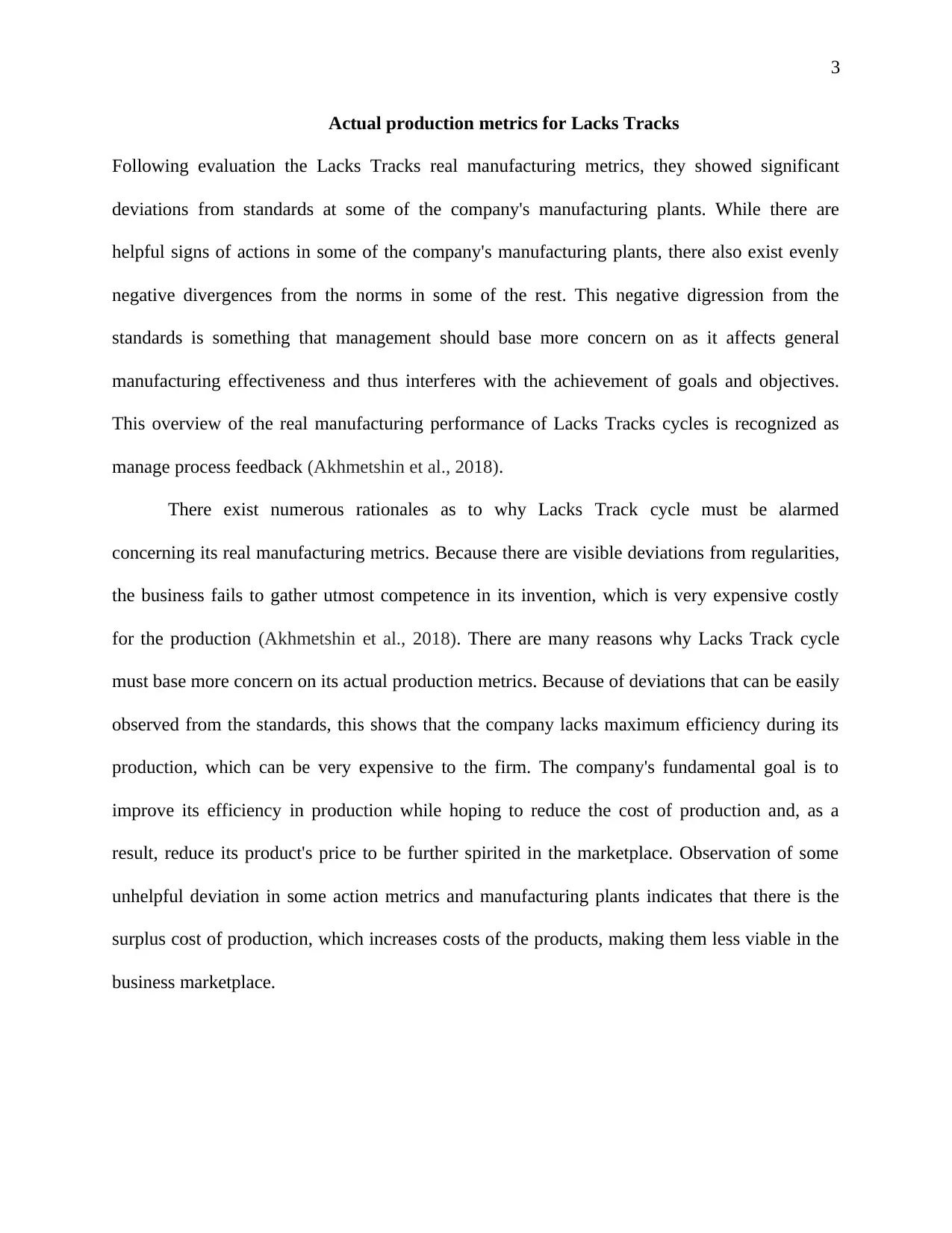
3
Actual production metrics for Lacks Tracks
Following evaluation the Lacks Tracks real manufacturing metrics, they showed significant
deviations from standards at some of the company's manufacturing plants. While there are
helpful signs of actions in some of the company's manufacturing plants, there also exist evenly
negative divergences from the norms in some of the rest. This negative digression from the
standards is something that management should base more concern on as it affects general
manufacturing effectiveness and thus interferes with the achievement of goals and objectives.
This overview of the real manufacturing performance of Lacks Tracks cycles is recognized as
manage process feedback (Akhmetshin et al., 2018).
There exist numerous rationales as to why Lacks Track cycle must be alarmed
concerning its real manufacturing metrics. Because there are visible deviations from regularities,
the business fails to gather utmost competence in its invention, which is very expensive costly
for the production (Akhmetshin et al., 2018). There are many reasons why Lacks Track cycle
must base more concern on its actual production metrics. Because of deviations that can be easily
observed from the standards, this shows that the company lacks maximum efficiency during its
production, which can be very expensive to the firm. The company's fundamental goal is to
improve its efficiency in production while hoping to reduce the cost of production and, as a
result, reduce its product's price to be further spirited in the marketplace. Observation of some
unhelpful deviation in some action metrics and manufacturing plants indicates that there is the
surplus cost of production, which increases costs of the products, making them less viable in the
business marketplace.
Actual production metrics for Lacks Tracks
Following evaluation the Lacks Tracks real manufacturing metrics, they showed significant
deviations from standards at some of the company's manufacturing plants. While there are
helpful signs of actions in some of the company's manufacturing plants, there also exist evenly
negative divergences from the norms in some of the rest. This negative digression from the
standards is something that management should base more concern on as it affects general
manufacturing effectiveness and thus interferes with the achievement of goals and objectives.
This overview of the real manufacturing performance of Lacks Tracks cycles is recognized as
manage process feedback (Akhmetshin et al., 2018).
There exist numerous rationales as to why Lacks Track cycle must be alarmed
concerning its real manufacturing metrics. Because there are visible deviations from regularities,
the business fails to gather utmost competence in its invention, which is very expensive costly
for the production (Akhmetshin et al., 2018). There are many reasons why Lacks Track cycle
must base more concern on its actual production metrics. Because of deviations that can be easily
observed from the standards, this shows that the company lacks maximum efficiency during its
production, which can be very expensive to the firm. The company's fundamental goal is to
improve its efficiency in production while hoping to reduce the cost of production and, as a
result, reduce its product's price to be further spirited in the marketplace. Observation of some
unhelpful deviation in some action metrics and manufacturing plants indicates that there is the
surplus cost of production, which increases costs of the products, making them less viable in the
business marketplace.
⊘ This is a preview!⊘
Do you want full access?
Subscribe today to unlock all pages.

Trusted by 1+ million students worldwide
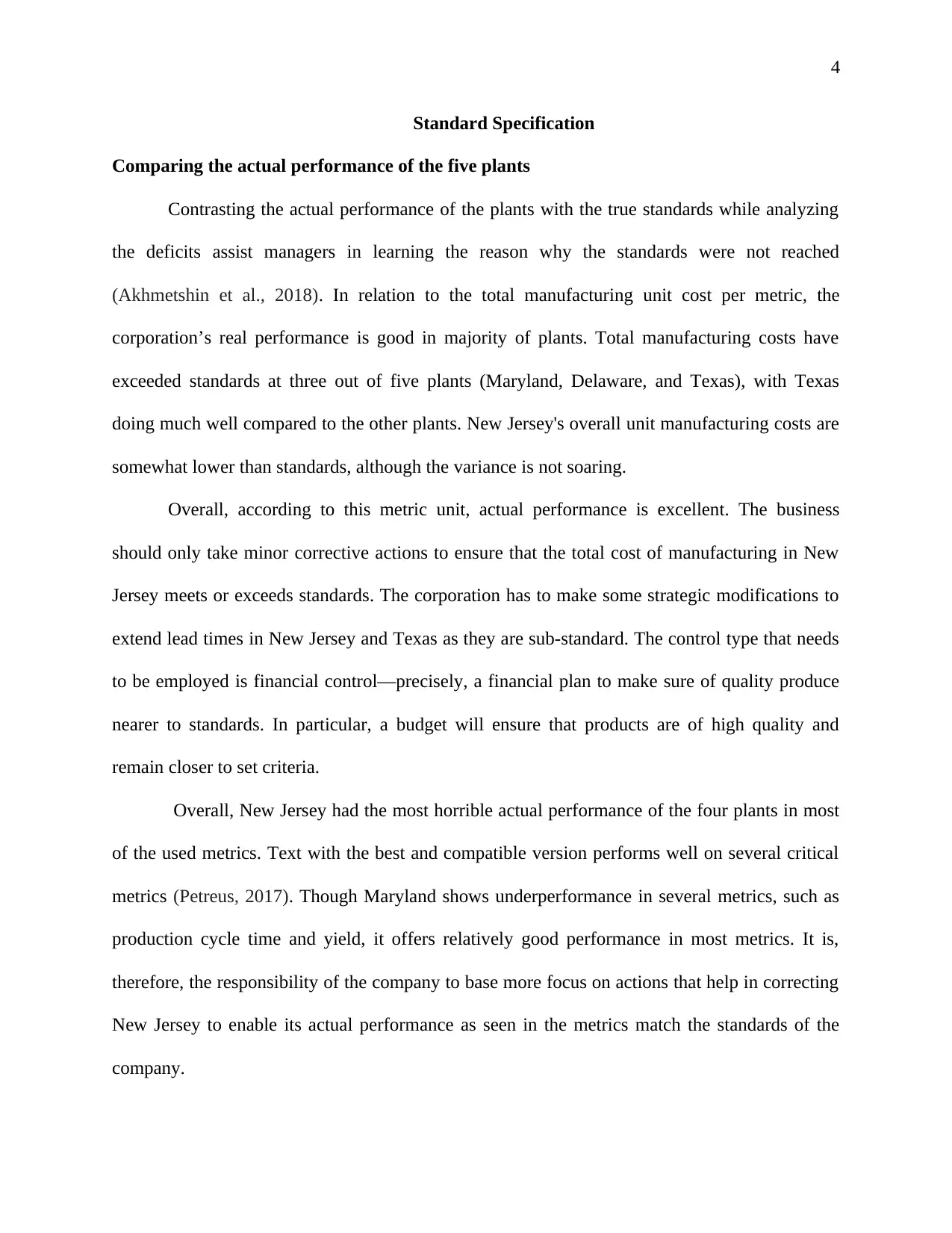
4
Standard Specification
Comparing the actual performance of the five plants
Contrasting the actual performance of the plants with the true standards while analyzing
the deficits assist managers in learning the reason why the standards were not reached
(Akhmetshin et al., 2018). In relation to the total manufacturing unit cost per metric, the
corporation’s real performance is good in majority of plants. Total manufacturing costs have
exceeded standards at three out of five plants (Maryland, Delaware, and Texas), with Texas
doing much well compared to the other plants. New Jersey's overall unit manufacturing costs are
somewhat lower than standards, although the variance is not soaring.
Overall, according to this metric unit, actual performance is excellent. The business
should only take minor corrective actions to ensure that the total cost of manufacturing in New
Jersey meets or exceeds standards. The corporation has to make some strategic modifications to
extend lead times in New Jersey and Texas as they are sub-standard. The control type that needs
to be employed is financial control—precisely, a financial plan to make sure of quality produce
nearer to standards. In particular, a budget will ensure that products are of high quality and
remain closer to set criteria.
Overall, New Jersey had the most horrible actual performance of the four plants in most
of the used metrics. Text with the best and compatible version performs well on several critical
metrics (Petreus, 2017). Though Maryland shows underperformance in several metrics, such as
production cycle time and yield, it offers relatively good performance in most metrics. It is,
therefore, the responsibility of the company to base more focus on actions that help in correcting
New Jersey to enable its actual performance as seen in the metrics match the standards of the
company.
Standard Specification
Comparing the actual performance of the five plants
Contrasting the actual performance of the plants with the true standards while analyzing
the deficits assist managers in learning the reason why the standards were not reached
(Akhmetshin et al., 2018). In relation to the total manufacturing unit cost per metric, the
corporation’s real performance is good in majority of plants. Total manufacturing costs have
exceeded standards at three out of five plants (Maryland, Delaware, and Texas), with Texas
doing much well compared to the other plants. New Jersey's overall unit manufacturing costs are
somewhat lower than standards, although the variance is not soaring.
Overall, according to this metric unit, actual performance is excellent. The business
should only take minor corrective actions to ensure that the total cost of manufacturing in New
Jersey meets or exceeds standards. The corporation has to make some strategic modifications to
extend lead times in New Jersey and Texas as they are sub-standard. The control type that needs
to be employed is financial control—precisely, a financial plan to make sure of quality produce
nearer to standards. In particular, a budget will ensure that products are of high quality and
remain closer to set criteria.
Overall, New Jersey had the most horrible actual performance of the four plants in most
of the used metrics. Text with the best and compatible version performs well on several critical
metrics (Petreus, 2017). Though Maryland shows underperformance in several metrics, such as
production cycle time and yield, it offers relatively good performance in most metrics. It is,
therefore, the responsibility of the company to base more focus on actions that help in correcting
New Jersey to enable its actual performance as seen in the metrics match the standards of the
company.
Paraphrase This Document
Need a fresh take? Get an instant paraphrase of this document with our AI Paraphraser

5
Four most essential and Common deviations from the standards
Plants actual performance in the utilization rate
It is the most easily noticeable deviation from the standards. Significant deviation can be
noticed from the majority of the standards apart from Texas. Worst performance and
considerable deviation from the norm is recognized in Delaware (Coffman et al., 2017). This
indicates that the company is not performing well in utilizing its capacity maximally in
Delaware, Maryland and New Jersey hence affecting overall production efficiency.
Average production downtime
From the plants, it is only Texas that has marched the standards. All the others have
deviated significantly, with Delaware leading with the worst deviation. This is a critical metric
since it is a determinant of many other factors such as manufacturing cycle time, the yield of
production, the unit cost of production, and the total number of units produced annually. Failing
to march the standard has a negative impact on the production efficiency of the company. There
is a need for the implementation of corrective actions in each plant to help in reducing the
percentage of downtime under the standards.
Defective rate
This is an essential metric; the business had poor performance in all other plants apart
from the Maryland plant. The majority of the plant's rates were at the standards, which could
cause much concern to the company's administration. Defective rate affects manufacturing
process by lowering it, and it is expensive to rectify the defection or doing the job again
(Akhmetshin et al., 2018).
Four most essential and Common deviations from the standards
Plants actual performance in the utilization rate
It is the most easily noticeable deviation from the standards. Significant deviation can be
noticed from the majority of the standards apart from Texas. Worst performance and
considerable deviation from the norm is recognized in Delaware (Coffman et al., 2017). This
indicates that the company is not performing well in utilizing its capacity maximally in
Delaware, Maryland and New Jersey hence affecting overall production efficiency.
Average production downtime
From the plants, it is only Texas that has marched the standards. All the others have
deviated significantly, with Delaware leading with the worst deviation. This is a critical metric
since it is a determinant of many other factors such as manufacturing cycle time, the yield of
production, the unit cost of production, and the total number of units produced annually. Failing
to march the standard has a negative impact on the production efficiency of the company. There
is a need for the implementation of corrective actions in each plant to help in reducing the
percentage of downtime under the standards.
Defective rate
This is an essential metric; the business had poor performance in all other plants apart
from the Maryland plant. The majority of the plant's rates were at the standards, which could
cause much concern to the company's administration. Defective rate affects manufacturing
process by lowering it, and it is expensive to rectify the defection or doing the job again
(Akhmetshin et al., 2018).

6
Poor performance in shipping damages
It is only a Texas plant that showed an excellent march in the shipping damages. The rest
of the plants exceeded the company's standards. This interferes with the delivery of goods by the
company hence damaging the reputation of the industry and the clients (Akhmetshin et al.,
2018).
Two Types of Controls that could be used by Lacks Management
Quality Assurance Control
The company can use quality assurance control during the production process; it helps in
reducing the amount of downtime and the defects in the plants (Prasad, 2020). It can be applied
at each stage of production to limit the chances of defective products in the process of
production.
Supervisory control
Proper monitoring of the employees during the production process ensures that all the
workers are assisted and produce standard products that meet the company's expectations
(Prasad, 2020).
Importance of Total Quality Management (TQM) at Lacks Tracks
Total quality management will be a very effective implementation at Lacks Tracks
because it helps reduce errors, defects, and expenditure, hence lowering the cost of production
and ensuring the efficiency of production (Petreus, 2017). This management provides constant
improvement to the performance of the company, thus enhancing productivity. It enhances the
productivity of the company by reducing cost, producing quality products and improving general
performance (Prasad, 2020).
Poor performance in shipping damages
It is only a Texas plant that showed an excellent march in the shipping damages. The rest
of the plants exceeded the company's standards. This interferes with the delivery of goods by the
company hence damaging the reputation of the industry and the clients (Akhmetshin et al.,
2018).
Two Types of Controls that could be used by Lacks Management
Quality Assurance Control
The company can use quality assurance control during the production process; it helps in
reducing the amount of downtime and the defects in the plants (Prasad, 2020). It can be applied
at each stage of production to limit the chances of defective products in the process of
production.
Supervisory control
Proper monitoring of the employees during the production process ensures that all the
workers are assisted and produce standard products that meet the company's expectations
(Prasad, 2020).
Importance of Total Quality Management (TQM) at Lacks Tracks
Total quality management will be a very effective implementation at Lacks Tracks
because it helps reduce errors, defects, and expenditure, hence lowering the cost of production
and ensuring the efficiency of production (Petreus, 2017). This management provides constant
improvement to the performance of the company, thus enhancing productivity. It enhances the
productivity of the company by reducing cost, producing quality products and improving general
performance (Prasad, 2020).
⊘ This is a preview!⊘
Do you want full access?
Subscribe today to unlock all pages.

Trusted by 1+ million students worldwide
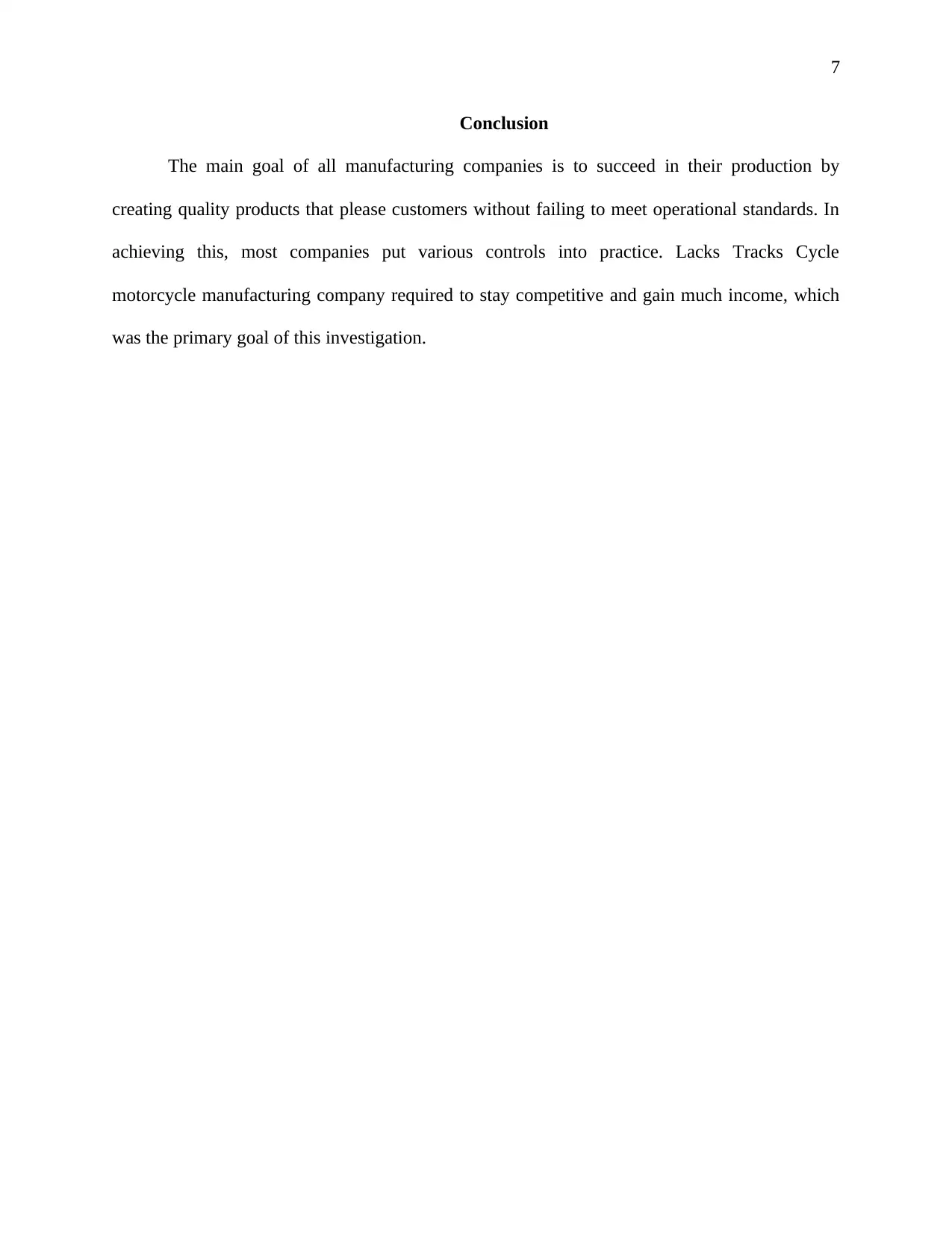
7
Conclusion
The main goal of all manufacturing companies is to succeed in their production by
creating quality products that please customers without failing to meet operational standards. In
achieving this, most companies put various controls into practice. Lacks Tracks Cycle
motorcycle manufacturing company required to stay competitive and gain much income, which
was the primary goal of this investigation.
Conclusion
The main goal of all manufacturing companies is to succeed in their production by
creating quality products that please customers without failing to meet operational standards. In
achieving this, most companies put various controls into practice. Lacks Tracks Cycle
motorcycle manufacturing company required to stay competitive and gain much income, which
was the primary goal of this investigation.
Paraphrase This Document
Need a fresh take? Get an instant paraphrase of this document with our AI Paraphraser
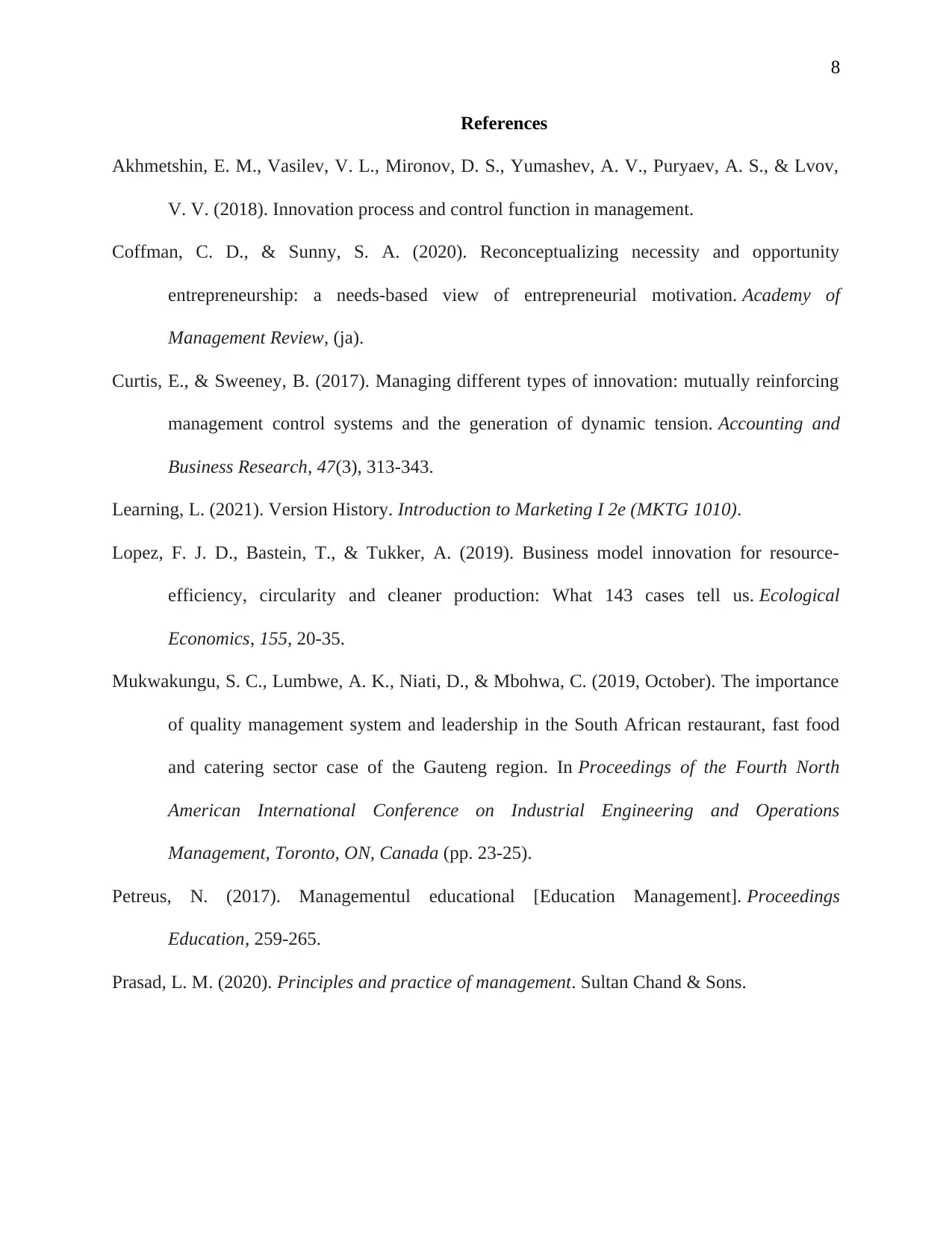
8
References
Akhmetshin, E. M., Vasilev, V. L., Mironov, D. S., Yumashev, A. V., Puryaev, A. S., & Lvov,
V. V. (2018). Innovation process and control function in management.
Coffman, C. D., & Sunny, S. A. (2020). Reconceptualizing necessity and opportunity
entrepreneurship: a needs-based view of entrepreneurial motivation. Academy of
Management Review, (ja).
Curtis, E., & Sweeney, B. (2017). Managing different types of innovation: mutually reinforcing
management control systems and the generation of dynamic tension. Accounting and
Business Research, 47(3), 313-343.
Learning, L. (2021). Version History. Introduction to Marketing I 2e (MKTG 1010).
Lopez, F. J. D., Bastein, T., & Tukker, A. (2019). Business model innovation for resource-
efficiency, circularity and cleaner production: What 143 cases tell us. Ecological
Economics, 155, 20-35.
Mukwakungu, S. C., Lumbwe, A. K., Niati, D., & Mbohwa, C. (2019, October). The importance
of quality management system and leadership in the South African restaurant, fast food
and catering sector case of the Gauteng region. In Proceedings of the Fourth North
American International Conference on Industrial Engineering and Operations
Management, Toronto, ON, Canada (pp. 23-25).
Petreus, N. (2017). Managementul educational [Education Management]. Proceedings
Education, 259-265.
Prasad, L. M. (2020). Principles and practice of management. Sultan Chand & Sons.
References
Akhmetshin, E. M., Vasilev, V. L., Mironov, D. S., Yumashev, A. V., Puryaev, A. S., & Lvov,
V. V. (2018). Innovation process and control function in management.
Coffman, C. D., & Sunny, S. A. (2020). Reconceptualizing necessity and opportunity
entrepreneurship: a needs-based view of entrepreneurial motivation. Academy of
Management Review, (ja).
Curtis, E., & Sweeney, B. (2017). Managing different types of innovation: mutually reinforcing
management control systems and the generation of dynamic tension. Accounting and
Business Research, 47(3), 313-343.
Learning, L. (2021). Version History. Introduction to Marketing I 2e (MKTG 1010).
Lopez, F. J. D., Bastein, T., & Tukker, A. (2019). Business model innovation for resource-
efficiency, circularity and cleaner production: What 143 cases tell us. Ecological
Economics, 155, 20-35.
Mukwakungu, S. C., Lumbwe, A. K., Niati, D., & Mbohwa, C. (2019, October). The importance
of quality management system and leadership in the South African restaurant, fast food
and catering sector case of the Gauteng region. In Proceedings of the Fourth North
American International Conference on Industrial Engineering and Operations
Management, Toronto, ON, Canada (pp. 23-25).
Petreus, N. (2017). Managementul educational [Education Management]. Proceedings
Education, 259-265.
Prasad, L. M. (2020). Principles and practice of management. Sultan Chand & Sons.
1 out of 8
Related Documents
Your All-in-One AI-Powered Toolkit for Academic Success.
+13062052269
info@desklib.com
Available 24*7 on WhatsApp / Email
![[object Object]](/_next/static/media/star-bottom.7253800d.svg)
Unlock your academic potential
Copyright © 2020–2025 A2Z Services. All Rights Reserved. Developed and managed by ZUCOL.




